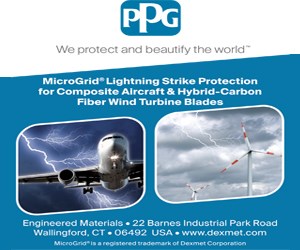US wind energy: Offshore promise remains unfulfilled, onshore strong
On the occasion of the laying of the first foundation for the first turbine in the first-ever offshore wind farm in the US, located three miles southeast of Block Island, RI, US (5 turbines, 30 MW, expected online in 2016), an article published by the US Energy Information Admin. (Washington, DC, US) by authors Rachel Marsh and Cara Marcy noted that this small beginning presages what could be profoundly significant opportunities to harvest wind energy off the US coast and ensure a long and steady demand for the composite materials and equipment necessary to build the massive blades that turn the turbine rotors.
On the occasion of the laying of the first foundation for the first turbine in the first-ever offshore wind farm in the US, located three miles southeast of Block Island, RI, US (5 turbines, 30 MW, expected online in 2016), an article published by the US Energy Information Admin. (Washington, DC, US) by authors Rachel Marsh and Cara Marcy noted that this small beginning presages what could be profoundly significant opportunities to harvest wind energy off the US coast and ensure a long and steady demand for the composite materials and equipment necessary to build the massive blades that turn the turbine rotors.
The authors note that The National Renewable Energy Laboratory (NREL, Golden, CO, US) estimates the US has 4,200 GW of developable offshore wind, compared to its estimate of 11,000 GW of onshore potential. Wind resources are classified on a scale of 0 to 7 (7 is best) based on power density, and more than 66% of offshore wind in the US is in class 6 or 7.
Marsh and Marcy note that wind turbine technology has grown steadily in Europe, and, to a lesser extent, in Asia. By 2014, Europe accounted for 90% of the estimated 8.8 GW of installed global offshore wind turbine capacity.
In the US, developers have proposed nearly 4.9 GW of offshore wind capacity off the coasts of nine states, but challenges remain even for projects that have advanced through key regulatory/market milestones. For example, Cape Wind, a 486-MW project proposed in 2001, faced litigation that halted its progress. Marsh and Marcy put the difference in European and US attitudes toward offshore wind down, in part, to the abundance of onshore wind opportunities in the US, many in relatively unpopulated areas, where challenges such as those that have delayed/cancelled projects in densely populated New England are less likely to crop up.
Related Content
-
Composites end markets: Batteries and fuel cells (2024)
As the number of battery and fuel cell electric vehicles (EVs) grows, so do the opportunities for composites in battery enclosures and components for fuel cells.
-
Composites end markets: Energy (2024)
Composites are used widely in oil/gas, wind and other renewable energy applications. Despite market challenges, growth potential and innovation for composites continue.
-
MingYang reveals 18-MW offshore wind turbine model with 140-meter-long blades
The Chinese wind turbine manufacturer surpasses its 16-MW platform, optimizes wind farm construction costs for 1-GW wind farms.













